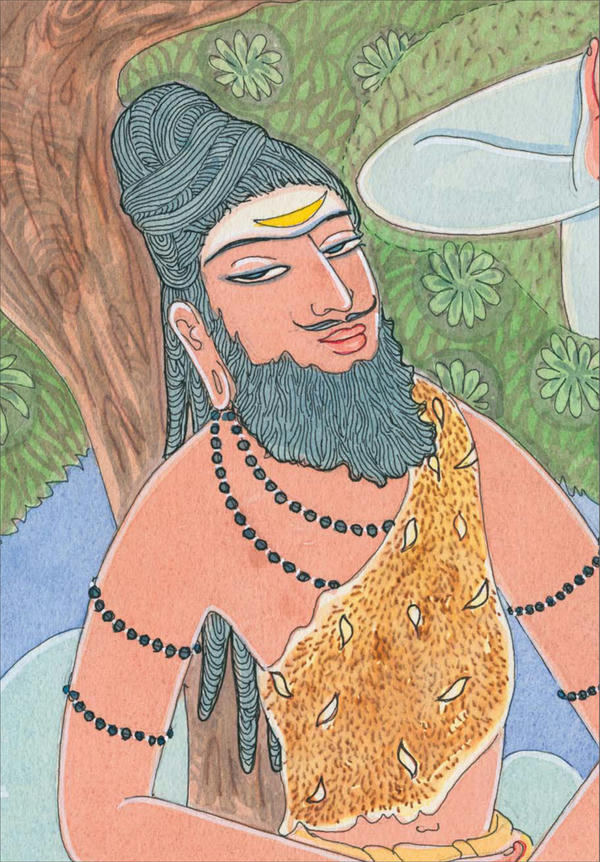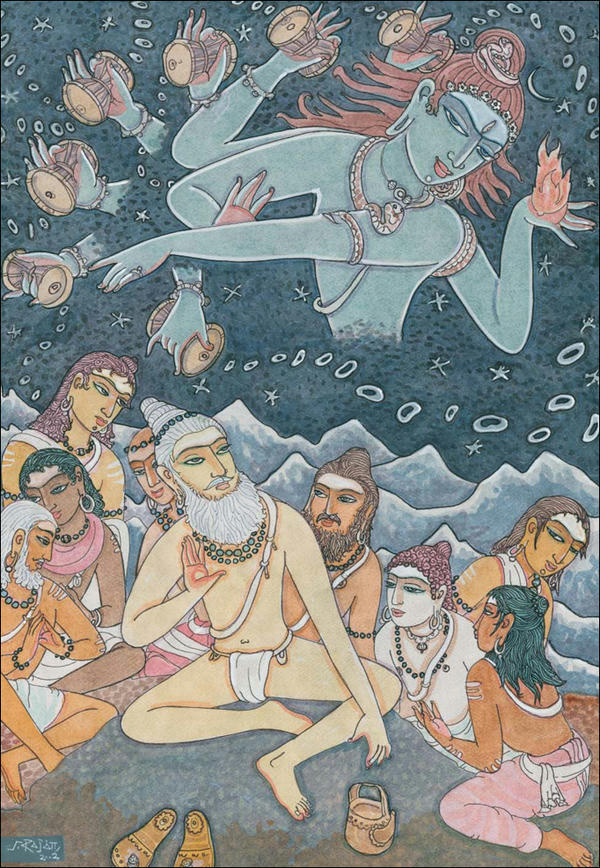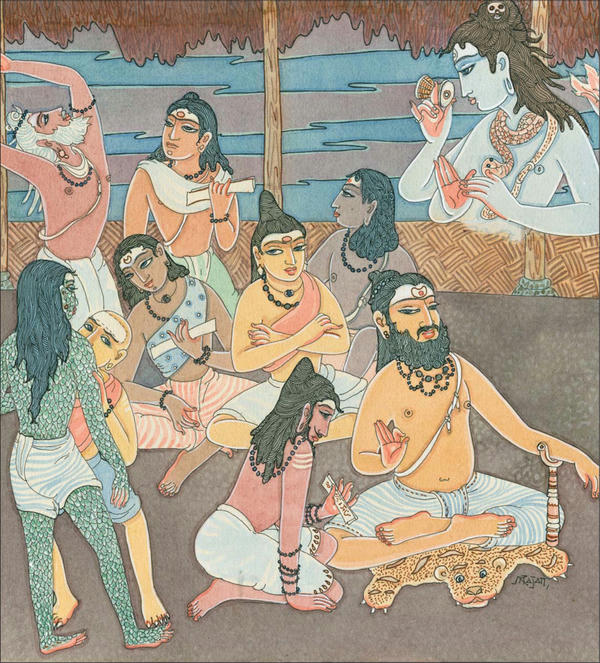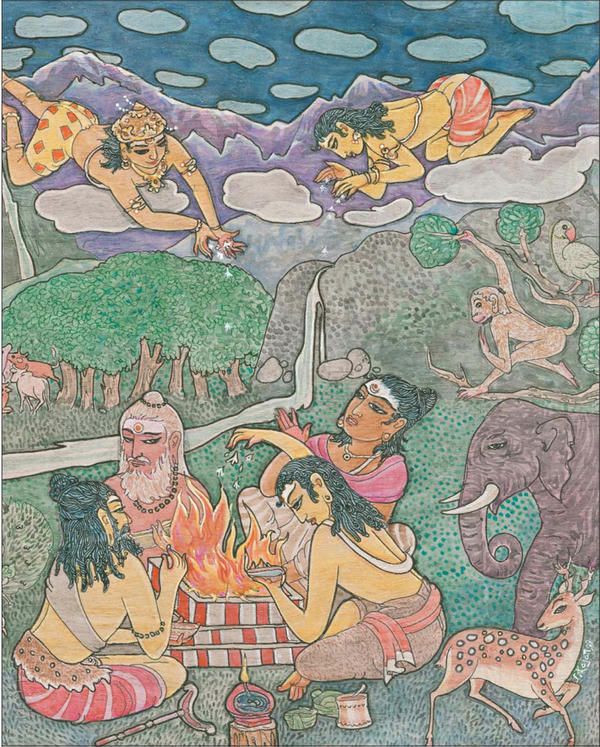Chapter Two
Maharishi Nandinatha
The Himalayan Hindus of two thousand years ago lived a rustic life, close to the land, close to their spiritual roots, close to one another, on whom they depended for sustenance. Hamlets and ashrams were always built near a river, fresh water being central to survival. Their thatched cottages took many shapes, mostly round and rectangular, engineered with four or six posts inside, over which a sheet of woven branches, grasses and leaves was layered. This thick sheet of thatch, rightly constructed, could keep the region’s brutal weather out. For further protection from the elements, the simple dwellings were sheltered strategically amid and beneath large trees. The huts were organic, providing warmth in the winter while being cool during the high-altitude, sun-intense summers. The floors, made of cooling earth mixed with cow dung and straw, were antiseptic and served the important task of repelling insects. Each day the dung floor was sprinkled with fresh water and buffed to renew the surface. §
Mountainous lands are severely sloped, so the Himalayan agriculturalists terraced the hills, a difficult but necessary task. They grew rice, cereals and garbanzo beans, lentils and root crops. (Roots were kept as famine foods, saved for the hardest of times). Fruits were abundant, and every home was planted with apricots and apples. Families kept bees for the honey and wax, cows for milk, goats for meat (not everyone was vegetarian, though most were) and to serve as beasts of burden, being so adept at rock climbing. They learned to cultivate grasslands for cattle grazing. They crushed their oil from mustard seeds, for eating, cooking and lighting the lamps. Mustard was so crucial to life that the oil was poured on either side of the home’s threshold when important visitors arrived.§
The mountains were crisscrossed with trails along which life-sustaining commodities traveled, to be traded at distant marketplaces. So narrow were the passageways that a single man or goat was all that could pass. These paths were called aja-patha, meaning “goat path” in Sanskrit. Each goat could only carry a few kilograms, so goods were chosen thoughtfully. The two primary routes of the day passed through Joshimath (a Saiva center), Badrinath (a Vaishnava center) and Kedarnath (a Saiva stronghold).§

Maharishi Nandinatha is the famed guru of Patanjali, Vyaghrapada and Tirumular, the Himalayan-dwelling siddha yogi and progenitor of the Nandinatha Sampradaya. He was the first known preceptor of this lineage, which imparts the advaitic (monistic) teachings of Saivism.
• • • • • • • • • • • • • • • • • • • • • • • •§
This pastoral life offered many opportunities for gatherings, especially in the ashrams, and the Himalayan Hindu holy men loved nothing more than to hold philosophical discourse and debates, often under the wide canopy of a ficus tree. Everyone would sit on the ground for these meetings. There were no books. Learning in those days was conveyed orally and committed to memory by the students. The spiritual elders had small mat-seats or wooden tables, called pitha, some six inches high, on which they would sit to guide the others and impart instructions to students of different ages. These rishis were often married men, not sannyasins. Some sannyasins also had disciples living with them, while others engaged in their spiritual meditation and other practices in strict seclusion.§
Students were of every age, having found their way to the remote teaching/living centers to be schooled in the ancient arts and sciences, to learn Sanskrit and to master a variety of skills for practical living. Every household served as a training center of farming skills and apprenticeship in other arts. Life in the Himalayan uplands was arduous, challenging and particularly conducive to religious and spiritual pursuits. It was regarded as a sacred region, where holy persons conversed with Divinities and lay persons traveled to ascend to paradise. The Joshimath-Badrinath route, famous for its pilgrimage sites, has been celebrated as the “path of ascent to heaven” (svarga-arohana) since the age of the epic Mahabharata.§

Lord Siva beats His drum fourteen times, issuing forth fourteen primal sounds to create the universe. High in the Himalayas, siddha Nandinatha sits with his eight yogic disciples to teach, for the first time in known human history, the revelatory truths of the monistic tradition of Saiva Siddhanta.
• • • • • • • • • • • • • • • • • • • • • • • •§
A Lineage of Masters
In this Himalayan remote there lived a great yogi known as Maharishi Nandinatha, a rare and illumined soul whose inner eye was opened to the perfection of the universe, a knower of Siva, of the Self God within. He himself derived from a long line of satgurus, whose names and biographies are lost, and thus he is regarded as the first known preceptor of the lineage known today as the Nandinatha Sampradaya, the Agamic tradition that Robert Hansen had discovered in Ceylon.§
Nandinatha had for his direct disciples the four sages—Sanaka, Sanantana, Sanatana and Sanatkumara—all bearing the title of Nandi. Besides them were Sivayoga Muni, Patanjali, Vyaghrapada and Tirumular (also known as Sundaranatha). All eight were the spiritual leaders of one of the initial Agamic schools and were known as Nathas. Of them, the first four received Lord Siva’s special grace and were commanded by Him to disperse themselves in the four directions, carrying the message of the Agamas. Once at their appointed destinations, they practiced intense yoga in the Agamic way—through sun and rain, hail and storm—and in time ascended to celestial status.§
The yogis around Maharishi Nandinatha were well versed in the Siva Sutras, whose aphorisms were regarded as the voice of Siva Himself—a puzzling, mathematically sophisticated set of fourteen couplets that seem to be about the Sanskrit alphabet, but on deeper reflection are a key to understanding the composition of the cosmos, showing how this language creates a mystical connection to the Divine from its very roots. The early tantric traditions, from Kashmir Saivism to Saiva Siddhanta, share a love of the Siva Sutras, those obscure, arcane, mysterious verses that yogis study even in the 21st century to delve into the mystical apprehension of the universes, gross and subtle. §

Maharishi Nandinatha sits on a tiger skin explaining a scriptural verse to Sundaranatha, as the other disciples confer, examine sacred texts and offer praise to God Siva.
• • • • • • • • • • • • • • • • • • • • • • • •§
These fourteen sutras—revealed to Panini, who wrote them down as a kind of yogic science notebook for its time—emanated from the drum held in the raised right hand of Lord Siva Nataraja. This science of sound and words remained a secret to most, for only the illumined could comprehend it, being unspoken knowledge directly from the Supreme Lord and beyond the reach of the ordinary mind. §
Sages like Sanaka, Sanatana, Sanatkumara, Patanjali and others were able to hear the transcendental sounds of Siva’s drum but were unable to grasp the inner, core meaning of the aphorisms. Legend says they approached Maharishi Nandinatha seeking an explanation. Moved by the sincerity of their search for this rare knowledge, the satguru proceeded to elucidate the essence of the sutras. He offered 27 verses, which are the only written teachings of this primal preceptor that have survived the tides of time, and thus form the oldest scriptural text from this Saiva Siddhanta lineage. Terse and wise, it is known as the Nandikeshvara Kashika. Kashika means “the illuminator.”§
It is said that Sri Nandikeshvara, as Maharishi Nandinatha is also known, accomplished the feat of explaining the inexplicable due to two things: his profound God Realizations, which gave him a oneness with Siva within, and the completion of a difficult, some would say impossible, austerity, that of reciting the epic chant Sri Rudram ten million times.§
Nandinatha’s Kashika is more a meditation than an explanation, a contemplation on thirty-six constituents of the universe, from the most subtle to the very earth on which we stand—Lord Siva’s unfoldment of the cosmos through sound, specific sounds that are embedded forever in the letters of the Sanskrit language. These constituents, or tattvas, are at the heart of the cosmology of Saiva Siddhanta, for in them can be found every level of consciousness, every element, every sense and color, every energy, vibration and sound that exists. Saiva Siddhanta speaks of 36 tattvas in all. Knowing the tattvas, one knows all. §
The ancient texts are dense, convoluted and opaque, for in those days the secrets of yoga and inner consciousness were thought too precious to be openly expressed. So they were concealed in a special kind of language, like a cryptogram, assuring that only those who were qualified would have access; others would be confounded. Indeed, reading these texts today is confounding, as this glimpse into the far past, into the heart of the progenitors of yoga, the Himalayan masters, proves. On the following pages is a selection of sutras from Maharishi Nandinatha’s 2,200-year-old philosophical text.§
Without the insights and commentary of knowers of God and Sanskrit pandits of the highest order, even these aphorisms, composed to elucidate the even more arcane fourteen Siva Sutras, may defy understanding. Here is Nandinatha’s verse ten, followed by a commentary by Sabharathnam Sivachariar:§
The Supreme Lord of all, denoted by the letter ṛi (ऋ), being in union with Sivashakti, denoted by the letter lṛi (ऌ), whose form is of the nature of pure consciousness, enters maya, activates it slightly, creates the world of movables and immovables and makes them expand. He does all this solely and absolutely, being One.§
COMMENTARY: When it is said that the Supreme Lord is absolutely One only, and that being in union with Shakti and by entering into maya He creates the world, it is observed that the concept of the nondual Lord gets affected. A defect occurs in the concept of advaita, as it is seen that, apart from the One Lord, there is the role of Sivashakti and maya. In this verse and in the succeeding three verses it is explained that there is no such defect in the concept of non-dual Lord. Ṛi (ऋ) denotes the Supreme Lord and lṛi (ऌ) denotes Shakti and maya. As stated in the Shri Tantra, the mind-form of Siva is Shakti, denoted by the letter lṛi (ऋ). The last letter, ka (क), the root word, means “brings out from the unmanifest.” Shakti constitutes the form of the Lord, and maya is a part of His form. A person is not in need of external help in making his bodily movements. So also, the Supreme Lord does not need an external help to make His form move and act. This is expressed by the term kevala. Apart from Siva, there does not prevail a separate existence for Shakti and maya.§
Two Streams of Teaching
Natha means “lord” or “master,” a knower of the Self who has mastered the intricacies of his inner bodies and states of mind. Through the millennia, Nathas have been conveyors of esoteric knowledge and wielders of siddhis, powers of the soul. Natha siddhas delve deep into the mind, invoking Siva’s grace, controlling the kundalini shakti. They worship with full heart and mind the Lord of Lords, Siva, and in yogic contemplation experience identity in His Being.§
The divine messages of the Eternal Truths and how to succeed on the path to enlightenment are locked within the Natha tradition. All that we know as Saivism today—Agamic temple worship, homa, sannyasa, sadhana, tapas, yoga, tantra and the theology of monistic theism—has been carried forward by the Himalayan orders of the Natha Sampradaya. Sampradaya means a living stream of tradition or theology. The Nathas are considered the source of hatha as well as raja yoga.§
This oldest of Saivite sampradayas existing today consists of two major streams: the Nandinatha Sampradaya and the Adinatha Sampradaya. The Adinatha Sampradaya’s earliest known exemplars were Maharishi Adinatha, Matsyendranatha and Gorakshanatha (ca 950), expounder and foremost guru of Siddha Siddhanta Saivism and founder of the well-known order of Kanphata yogis.§
In the twenty-first century, the Adinatha and Nandinatha Sampradayas are both vibrant and vital. They share a common ground of theology, principles, sadhanas and many scriptures, including the Vedas, Agamas and Patanjali’s Yoga Sutras, though historical, societal and geographical forces over the past 1,000 years have shaped differences between them. Much of what is written by scholars about the Nathas refers to the northern Gorakshanatha school and lifestyle, rather than the Tirumular school. §
The two streams diverge in important ways. The foremost exposition of the Nandinatha Sampradaya is Tirumular’s Tirumantiram (ca 200 bce), while that of the Adinatha Sampradaya is Gorakshanatha’s Siddha Siddhanta Paddhati (ca 950 ce). Most texts of the Nandinatha Sampradaya are in the Tamil language, while those of the Adinatha are in Sanskrit. The Nandinatha Sampradaya is most influential in Sri Lanka and the South of India, while the Adinatha Sampradaya is most prominent in the North of India. The philosophy of the Nandinatha Sampradaya is known as Saiva Siddhanta, while that of the Adinatha Sampradaya is known as Siddha Siddhanta. The primary philosophical difference concerns the means of liberation from rebirth: Adinathas hold that liberation is entirely dependent on our own thoughts and actions, while Nandinathas believe it cannot be attained without Siva’s grace.§
The Nandinatha Sampradaya values highly the necessity of a living preceptor who keeps the channels open to Lord Murugan, the first renunciate and traditional progenitor of the lineage. Tirumular wrote:§
Illuminating it is to perceive the guru’s sacred person;
Illuminating it is to chant the guru’s sacred name;
Illuminating it is to listen to the guru’s sacred word;
Illuminating it is to reflect on the guru’s person. 139§
The Nandinatha Sampradaya is a siddha yoga tradition (siddha means “attainment”), and its gurus have often demonstrated great mystical abilities and wisdom. It is said that these teachers have realized their oneness with the Supreme God Siva and have merged as completely as humanly possible with this Divine source of all. With such realization comes limitless bliss and direct command of every power in the universe. There are many accounts of miraculous powers demonstrated by the masters of this lineage. The aid, even the glance, of such a highly realized siddha can quicken spiritual practice. It is believed that without the diksha (initiation) of such teachers, the human instincts will always fail to lead to this highest realization.§

The yogis of yore lived in the forests and jungles, often on the banks of rivers. There they performed spiritual disciplines, restraining the senses and driving consciousness deeper and deeper within. That inner worship was balanced by outer worship, commonly through a fire ceremony called homa, a mystical communion with the Deities and the inner worlds still performed by Hindus around the world.
• • • • • • • • • • • • • • • • • • • • • • • •§
The Natha Sampradaya is an initiatory guru-shishya tradition. Membership in the sampradaya is always conferred by initiation from a diksha guru, either the lineage-holder or another member of the sampradaya whose ability to initiate has been recognized by his diksha-guru.§
The Natha initiation is conducted as a formal ceremony in which some portion of the awareness and spiritual energy (shakti) of the guru is transmitted to the shishya (student). The neophyte, now a Natha, is given a new name with which to support his new identity. This transmission, or “touch,” of the guru is symbolically fixed by the application of holy ash to several parts of the body. In The Phantastikos, Shri Gurudev Mahendranath, a preceptor of the Adinatha Sampradaya, wrote:§
The passage of wisdom and knowledge through the generations required the mystic magic phenomenon of initiation, which is valid to this day in the initiation transmission from naked guru to naked novice by touch, mark and mantra. In this simple rite, the initiator passes something of himself to the one initiated. This initiation is the start of the transformation of the new Natha. It must not be overlooked that this initiation has been passed on in one unbroken line for thousands of years. Once you receive the Natha initiation, it is yours throughout life. No one can take it from you, and you yourself can never renounce it. This is the most permanent thing in an impermanent life.§
Indian alchemy, known as rasayana—involving the ritual, spiritual and medicinal uses of mercury, cinnabar and other minerals, crystal preparations and elixirs—is practiced by the Natha siddhas. The primary aim of the Natha siddhas is to achieve liberation, or moksha, during their current lifespan.§
According to Gurudev Mahendranath, another aim is to avoid reincarnation: “Our aims in life are to enjoy peace, freedom and happiness in this life, but also to avoid rebirth onto this Earth plane. All this depends not on divine benevolence, but on the way we ourselves think and act.” This last statement would not find agreement among proponents of the Nandinatha Sampradaya, however. In Saiva Siddhanta, as expressed by Tirumular himself, it is precisely Siva’s grace, and only that, which bestows the ultimate gift of liberation. §
Himself will create, Himself will protect,
Himself will annihilate, Himself will obscure,
Himself having done these, He will bestow liberation.
Himself will pervade and be the chief, too. 1809§